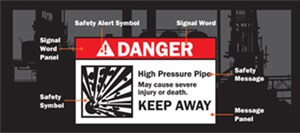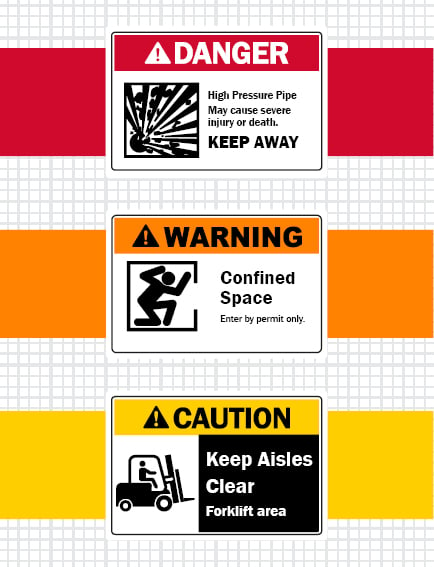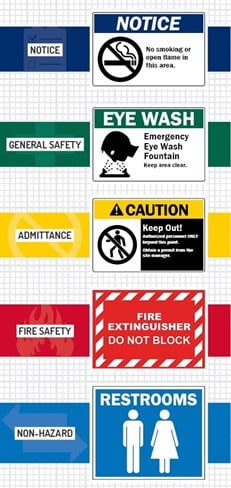Five Ways to Meet OSHA Requirements for Safety Signage

Every day, American workers service high-powered equipment, build and fix roads, and manufacture the goods we use on a regular basis.
They shouldn't put themselves at risk when doing so, but nearly 3 million employees are injured on the job each year. Work safety has improved in recent years, yet further action must be taken to ensure workers can enjoy a workplace free from hazards.
Safety signs can play a vital role in ensuring a safe workplace. Employers who implement effective, clear visual communication may enjoy fewer accidents and injuries, increased efficiency, and safe behavior throughout their facility.
How can employers realize these benefits and comply with federal standards for visual communication? Here are five ways to meet OSHA requirements for safety signage.
1) Understand ANSI and OSHA Requirements for Signage
29 CFR 1910.145, OSHA's guideline for signs and tags that identify hazards, outlines design requirements and specifies when safety signs must be used. These design elements are expanded upon in the ANSI Z535 standard, which utilizes alert symbols and pictograms to communicate hazards.
The ANSI Z535 standard dictates every aspect of sign design, including:
- Standard sign and label colors
- Signal words (such as "Danger" and "Warning")
- Letter style and size
- Sign and label placement

Duralabel has produced an infographic that broadly covers OSHA safety signs and the ANSI Z535 design standard.
ANSI last updated the Z535 safety sign standard in 2017; employers should use the latest standard when printing new labels. Replacing old ANSI signs is voluntary for now, but employers should consider updating to minimize confusion.
2) Recognize the Different Types of Safety Signs

OSHA and ANSI have established three primary severity classifications for safety signs. They are danger signs, warning signs, and caution signs; each relates directly to the severity of hazards present (or potentially present).
- Danger: Danger signs signal the most serious hazards, where special precautions must be taken. The "DANGER" signal word is printed in white letters on a red background and is preceded by the safety alert symbol, which looks like an exclamation point inside a triangle. This type of sign indicates that death or serious injury is almost certain to occur if the hazard is not avoided.
- Warning: This sign describes a hazard that may result in death or serious injury, but where the overall risk is not severe enough to need a danger sign. A safety alert symbol precedes the "WARNING" signal word, which is printed in black on an orange background.
- Caution: The hazards described on a caution sign may result in minor or moderate injuries if not avoided. These typically caution against unsafe practices. On caution signs, the "CAUTION" signal word is printed in black on a yellow background header and is preceded by the safety alert symbol.
Biological hazards are grouped into another hazard classification. These signs alert employees to the presence-or potential presence-of biohazards (including materials, equipment, containers, and rooms) where workers may be at risk of exposure.
Learn more about OSHA and ANSI standards, sign classifications, safety symbols and more with Duralabel' free Best Practice Guide to OSHA Safety Signs.
3) Know the Different Types of Safety Signage

Safety signs and labels should be posted whenever hazards may be present throughout a facility. Yet other types of signs can help employees stay safe and productive without pointing out specific hazards. They include:
- Notice: Use notice signs to deliver information about a machine, building, area, or equipment. These signs outline procedures, maintenance information, instructions, rules, and directions unrelated to personal injuries.
- General safety signs: These offer broad safety-related messages, typically relating to health, medical equipment, sanitation, first aid, housekeeping, and suggested general safety measures.
- Admittance: Admittance signs alert and explain the dangers and consequences associated with entering a restricted area.
- Fire safety: Fire safety signs point out emergency firefighting equipment and fire exits.
- Non-hazard signs: These communicate general safety facility information, such as wayfinding directions procedures, usually through simple text and clear symbols. These should be never be used to communicate hazards, risks, or dangers; they are not technically safety signs but nevertheless promote a safer workplace.
4) Learn Where to Place Safety Signs
It can be tough to know when and where signs should be placed throughout a facility. For quick reference, here is a quick primer on sign placement.
OSHA Offers Clear Guidance for When to use Safety Signage.
29 CFR 1910.145(f)(3) is OSHA's rule for when and where signs should be placed within a facility. The standard points out that labels, tags, and signs:
"Shall be used as a means to prevent accidental injury or illness to employees who are exposed to hazardous or potentially hazardous conditions, equipment or operations which are out of the ordinary, unexpected or not readily apparent. Tags shall be used until such time as the identified hazard is eliminated or the hazardous operation is completed."
Once you've determined that safety signage is necessary, 29 CFR 1910.145(f)(4)(vi) states that signs must be placed "as close as safely possible" to the nearby hazard.
OSHA Outlines Different Guidelines for Placement, Depending on the Type of Sign
Not sure which sign to place near a hazard? Here's a quick breakdown:
- Danger signs must be placed where a hazard poses an immediate danger and special precautions must be taken.
- Caution signs must be posted to warn of potential hazards; they may also be used to caution against unsafe practices.
- Safety instruction signs should be used wherever general instructions and safety suggestions can help workers perform their tasks in a safe manner.
Workers Must be Able to see the Signs From a Safe Distance
29 CFR 1910.145(f)(4) requires the sign's signal word-"Danger," "Caution," etc.-to be readable from at least five feet away.
Broadly speaking, signs should be placed such that workers are aware of the hazard and able to respond appropriately before being exposed to it.
The Sign Itself Should not Cause a Hazard
Safety signs should have rounded or blunt corners, and have no sharp edges, burrs, or splinters. Similarly, a sign that warns pedestrians to look out for forklift traffic at an intersection should not block their view of incoming forklifts.
5) Meet OSHA Requirements for Safety Signage with the Right Gear
Take the first step toward developing strong custom visual communication with DuraLabel industrial label and sign printers by Duralabel. Our printers accommodate various supplies, sizes, and types of signs, ensuring you're able to create the right signage for your facility.
Use your printer with more than 50 labeling supplies suited to a variety of application-specific uses. The right choice of materials will work on abrasive and uneven surfaces, remain bright in low-light areas, resist saltwater exposure, stay strong in greasy environments, or retain effectiveness in refrigerated settings.
Complement your custom signs with our selection of pre-made safety signs, available in various materials and sizes. Need more help? Download our free guide on OSHA signs.
Related Resources

Why Arc Flash Labels Matter for Electrical Safety
Why Are Arc Flash Labels Important? When electrical equipment must be maintained or repaired while energized, ...
Read
The Overlooked Fix That Improves Electrical Panel Safety
How Do Electrical Panel Labels Improve Safety and Compliance? Electrical panels are essential to every ...
Read
Print Electrical Safety Signs with a Thermal Transfer Printer
Why Are Electrical Safety Signs Essential for Compliance? Electrical safety is a major problem in modern ...
Read.png)




